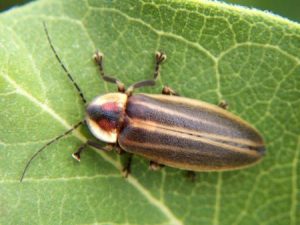 |
| Adult Firefly - Photuris lucicrescens |
I'm sure many New Jersey residents have childhood memories of fireflies. They might have been an insect that you capture in a jar. Perhaps you are still are lucky enough to see them at night. I'm seeing fewer in my suburban Jersey backyard.
There are at least 125 species of fireflies in the United States, but none are protected by the Endangered Species Act. The threats to them are the development of wetlands and insecticide spraying that is meant to target mosquitoes. But it is disruptions in their habitat while they are young - such as construction - that can extinguish an entire population.
Fireflies or lightning bugs aren't flies or bugs. They are soft-winged beetles. What everyone knows them for is that they can produce light and this ability in a living organism is called bioluminescence and it is relatively rare.
Birds and other predators quickly learn to avoid them because many species of fireflies protect themselves from predators with chemicals called lucibufagins which are toxic in the right doses, but also extremely distasteful.
The light comes from special organs in their abdomens that combine the luciferin with oxygen. Entomologists think they control their flashing by regulating how much oxygen goes to their light-producing organs.
Fireflies use that blinking to find mates but it may have evolved as a way to ward off predators. The males fly around and flash a signal unique to their kind, and the females watch for males. When a female sees one doing a good job of making her species’ signal, she flashes back with a species-appropriate flash of her own. And maybe they will mate.
Scientists think the males synchronize so everyone has a chance to look for females. These displays can be quite large and spectacular and in some places (like one forest in Tennessee) crowds assemble to watch.
To most of us, fireflies are kind of magical and harmless creatures. They don't bite. They don't do significant damage to plants. They just want a stable woodland, meadow or marsh habitat. Their lifecycle runs a year or more and they spend most of their lives as larvae preying on earthworms and other animals in the soil or leaf litter. Oddly, most adults don’t feed at all.
Further Reading
theconversation.com/how-fireflies-glow-and-what-signals-theyre-sending
countryliving.com/life/a39391/where-have-all-the-fireflies-gone/





